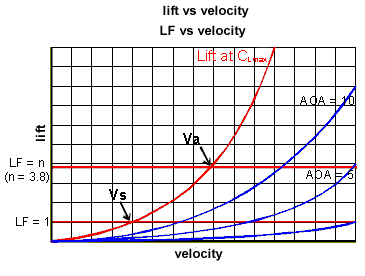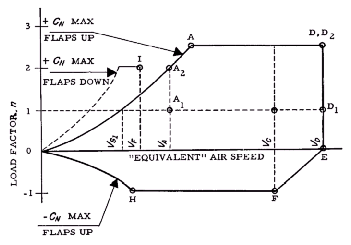
manoeuvring speedOne of the most commonly
stated definitions of the Manoeuvring speed, is the speed at which
the pilot can use full control deflections without over-stressing the
airplane. The above definition is reasonably correct, although it
should be limited to "full nose up control deflections" without
over-stressing the airplane. This definition however does not give us the
insight we need to create an equation which will give us the Manoeuvring
speed of our airplane. To do that we need to consider why there is a speed
below which it is impossible to overstress the airplane.

In the diagram to the
right the maximum lift the wing can produce is shown in red. The LF=1 line
shows the stall speed, as we learned in the previous section. The LF=n
(n=3.8) line shows the minimum speed at which the wing can produce lift
equal to the design Load Factor. This is the definition of Manoeuvring
speed we need.
The Manoeuvring Speed is the
minimum speed at which the wing can produce lift equal to the design load
limit. Below this speed the wing can not produce enough lift to
overstress the aircraft, no matter what angle of attack is used.
The design load limit is specified by the
FAA for USA designed aircraft and Transport Canada for Canadian designed
aircraft. In Module 5 we will explore all the aircraft limitations
required by law.
For most normal aircraft the design load
limit is 3.8g.
Manoeuvring Speed Formula
It is obvious that the Manoeuvring speed
is closely related to the stall speed. We could in fact create a formula
for Manoeuvring speed which is identical to the stall speed equation
except with lift equal to n times the weight:

This equation is virtually identical to
the Stall speed equation:

The only difference is that the
Manoeuvring speed depends upon the square root of nW not just the square
root of W. Therefore we can express Va in terms of Vs as:


|
